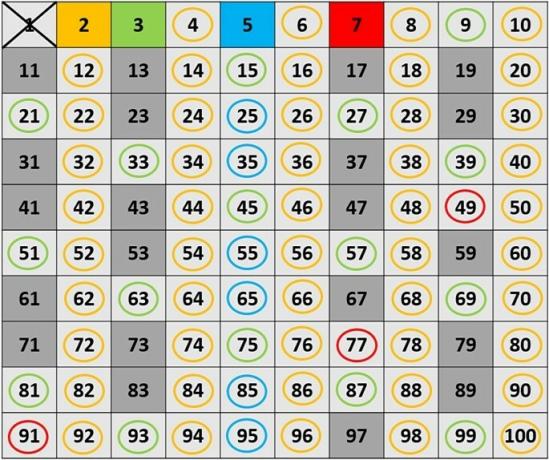Prime numbers are those that have only two divisors: one and the number itself. They are part of the set of natural numbers.
For example, 2 is a prime number as it is only divisible by one and itself.
When a number has more than two divisors they are called composite numbers and can be written as a product of prime numbers.
For example, 6 is not a prime number, it is a composite number as it has more than two divisors (1, 2 and 3) and is written as the product of two prime numbers 2 x 3 = 6.
Some considerations about prime numbers:
- The number 1 is not a prime number as it is only divisible by itself;
- The number 2 is the smallest prime number and also the only one that is even;
- The number 5 is the only prime number ending in 5;
- The other prime numbers are odd and end with the digits 1, 3, 7 and 9.
How do you know if a number is prime?
One way to find a prime number is to use the Sieve of Eratosthenes.
- Create a table and write the numbers in a range, for example from 1 to 100.
- The number 1 can be eliminated as it is not a prime number.
- Mark all prime numbers less than 10 (2, 3, 5 and 7) with different colors.
- Eliminate multiples of these numbers by marking them with their respective colors.
- The remaining numbers in the table, which have not been checked, are the prime numbers.

From the table we can see that there are 25 prime numbers between 1 and 100. Are they:
2, 3, 5, 7, 11, 13, 17, 19, 23, 29, 31, 37, 41, 43, 47, 53, 59, 61, 67, 71, 73, 79, 83, 89 and 97.
Another way to recognize a prime number is to perform divisions with the investigated number. To make the process easier, see some divisibility criteria.
Divisibility by 2: every number whose unit digit is even is divisible by 2;
Divisibility by 3: a number is divisible by 3 if the sum of its digits is a number divisible by 3;
Divisibility by 5: a number will be divisible by 5 when the unit digit is equal to 0 or 5.
If the number is not divisible by 2, 3 and 5 we continue the divisions with the next prime numbers less than the number until:
- If it is an exact division (rest equals zero) then the number is not prime.
- If it is an inexact division (non-zero remainder) and the quotient is smaller than the divider, then the number is prime.
- If it is an inexact division (non-zero remainder) and the quotient is equal to the divisor, then the number is prime.
Solved example: check if the number 113 is prime.
About number 113, we have:
- It does not have the last even digit and, therefore, is not divisible by 2;
- The sum of its digits (1+1+3 = 5) is not a number divisible by 3;
- It doesn't end in 0 or 5, so it's not divisible by 5.
As we have seen, 113 is not divisible by 2, 3 and 5. Now, it remains to be seen whether it is divisible by prime numbers smaller than it using the division operation.
Division by prime number 7:
Division by prime number 11:
Note that we have arrived at an inexact division whose quotient is less than the divisor. This proves that the number 113 is prime.
Prime numbers from 1 to 1000
Check out the 168 prime numbers between 1 and 1000.
Prime numbers from 1 to 10:
2, 3, 5, 7
Prime numbers from 10 to 100:
11, 13, 17, 19, 23, 29, 31, 37, 41, 43, 47, 53, 59, 61, 67, 71, 73, 79, 83, 89, 97
Prime numbers from 100 to 200:
101, 103, 107, 109, 113, 127, 131, 137, 139, 149, 151, 157, 163, 167, 173, 179, 181, 191, 193, 197, 199
Prime numbers from 200 to 300:
211, 223, 227, 229, 233, 239, 241, 251, 257, 263, 269, 271, 277, 281, 283, 293
Prime numbers from 300 to 400:
307, 311, 313, 317, 331, 337, 347, 349, 353, 359, 367, 373, 379, 383, 389, 397
Prime numbers from 400 to 500:
401, 409, 419, 421, 431, 433, 439, 443, 449, 457, 461, 463, 467, 479, 487, 491, 499
Prime numbers from 500 to 600:
503, 509, 521, 523, 541, 547, 557, 563, 569, 571, 577, 587, 593, 599
Prime numbers from 600 to 700:
601, 607, 613, 617, 619, 631, 641, 643, 647, 653, 659, 661, 673, 677, 683, 691
Prime numbers from 700 to 800:
701, 709, 719, 727, 733, 739, 743, 751, 757, 761, 769, 773, 787, 797
Prime numbers from 800 to 900:
809, 811, 821, 823, 827, 829, 839, 853, 857, 859, 863, 877, 881, 883, 887
Prime numbers from 900 to 1000:
907, 911, 919, 929, 937, 941, 947, 953, 967, 971, 977, 983, 991, 997
Also read about:
- dividers
- Multiples and Dividers
- What are prime numbers?
